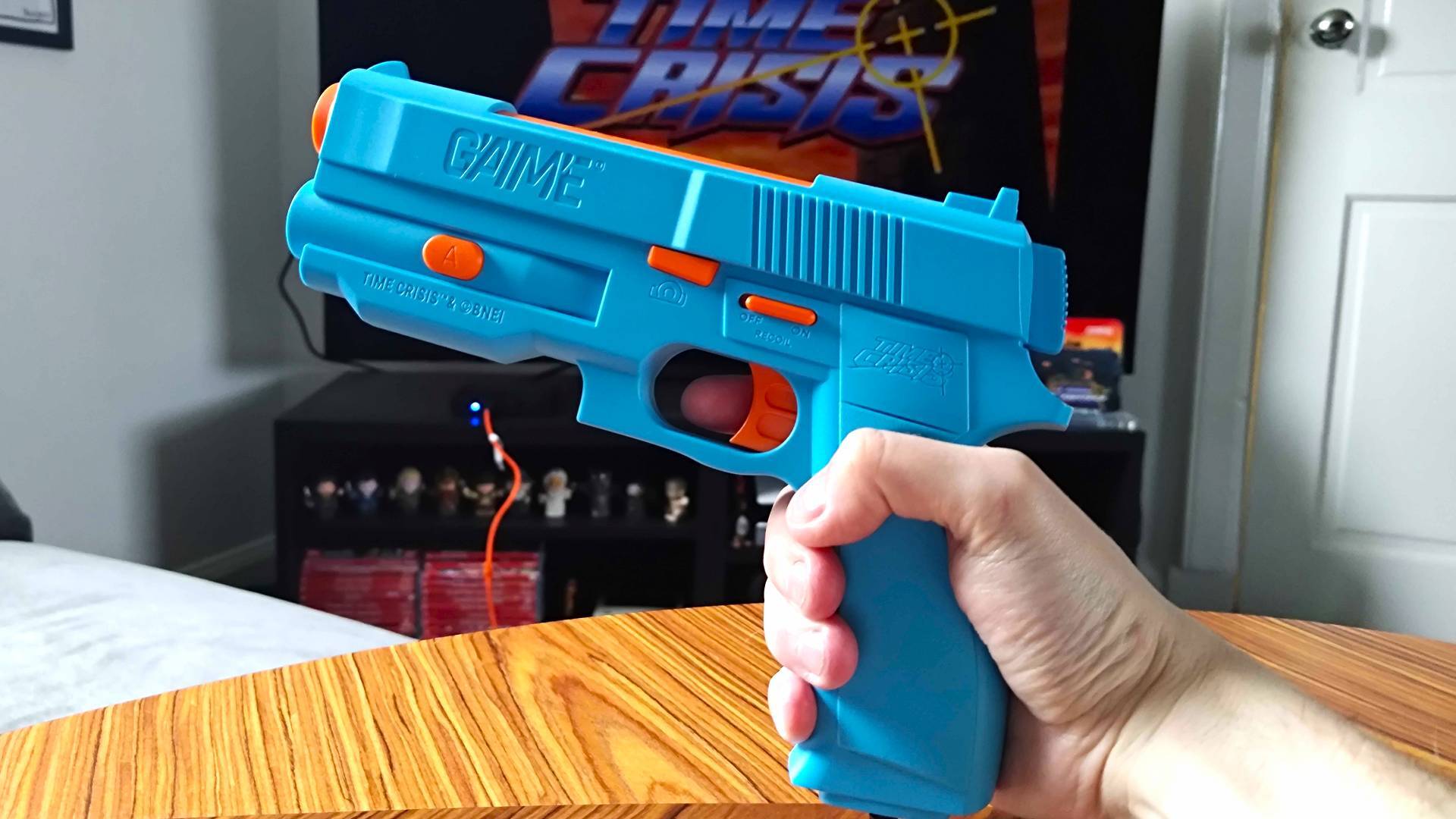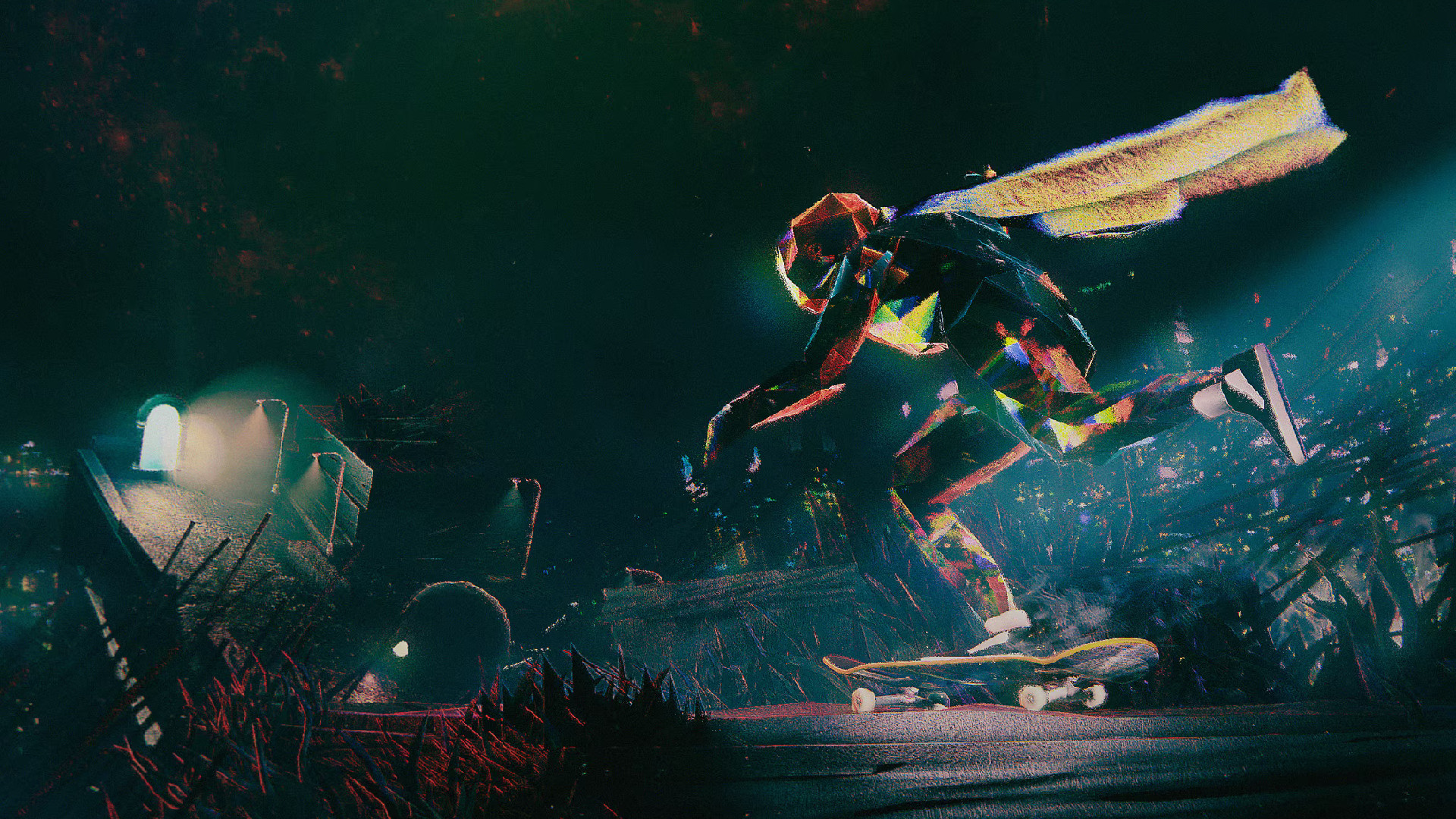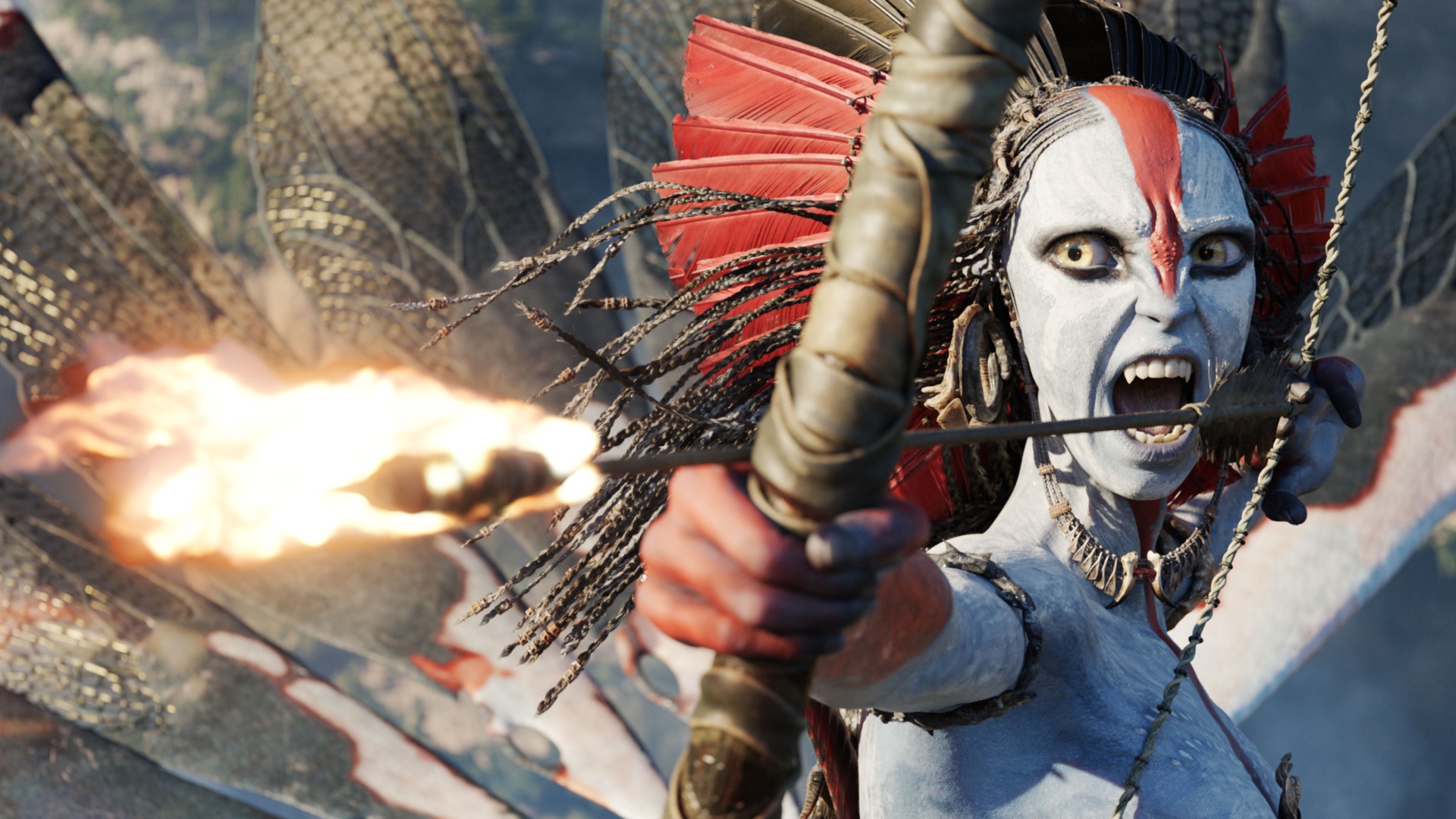GamesRadar+ Verdict
The G'AIM'E Time Crisis Lightgun console is a fantastic tribute to Bandai Namco's legendary shooter, and it marks a strong return for the genre. While the plug-and-play system makes for a great way to play the 1995 arcade adventure on a modern TV with proper accuracy, you won't be able to play more than four classic capers without potentially buying a new box in the future.
Pros
- +
Great modern lightgun solution
- +
Solid port of Time Crisis
- +
Very easy to set up
- +
Optional pedal adds extra arcade immersion
Cons
- -
Basic pack only includes Time Crisis
- -
No way to add more games
- -
Lack of graphical settings
Why you can trust GamesRadar+
I hate to admit it, but after a solid week using the G’AIM’E Time Crisis Lightgun console, it’s safe to say the president’s daughter would be a goner. Yes, my skills with a plastic firearm have diminished since my glory days standing on the sticky carpet of my local amusement centre, wearing size 1 sneakers, but this ultra-convenient arcade machine stand-in could help me properly hone my skills at home.
Starting at $99 / £99, the G’AIM’E Time Crisis console is both a celebratory system and a mainstream revival of a deceased genre. Not only does its release line up Bandai Namco’s cheesy clockwatching shooter turning 30, but it also serves as a fully licensed way to play up to four different arcade classics on your TV using authentic-feeling lightguns. Many of you probably haven’t clutched onto a plastic gun since the Spice Girls were a thing, and that’s exactly what this system is aiming to address.
Technically speaking, this G’AIM’E console is now one of the only best retro console contenders on the battlefield for lightgun games. By that, I mean it’s currently the only approachable device out there, as even new-age peripherals like the PS Move controllers have fallen out of fashion. That said, I do think Tassei Denki Co. has missed a trick when it comes to longevity, as there’s no way to add new games to this plug-and-play box.
What’s in the box?
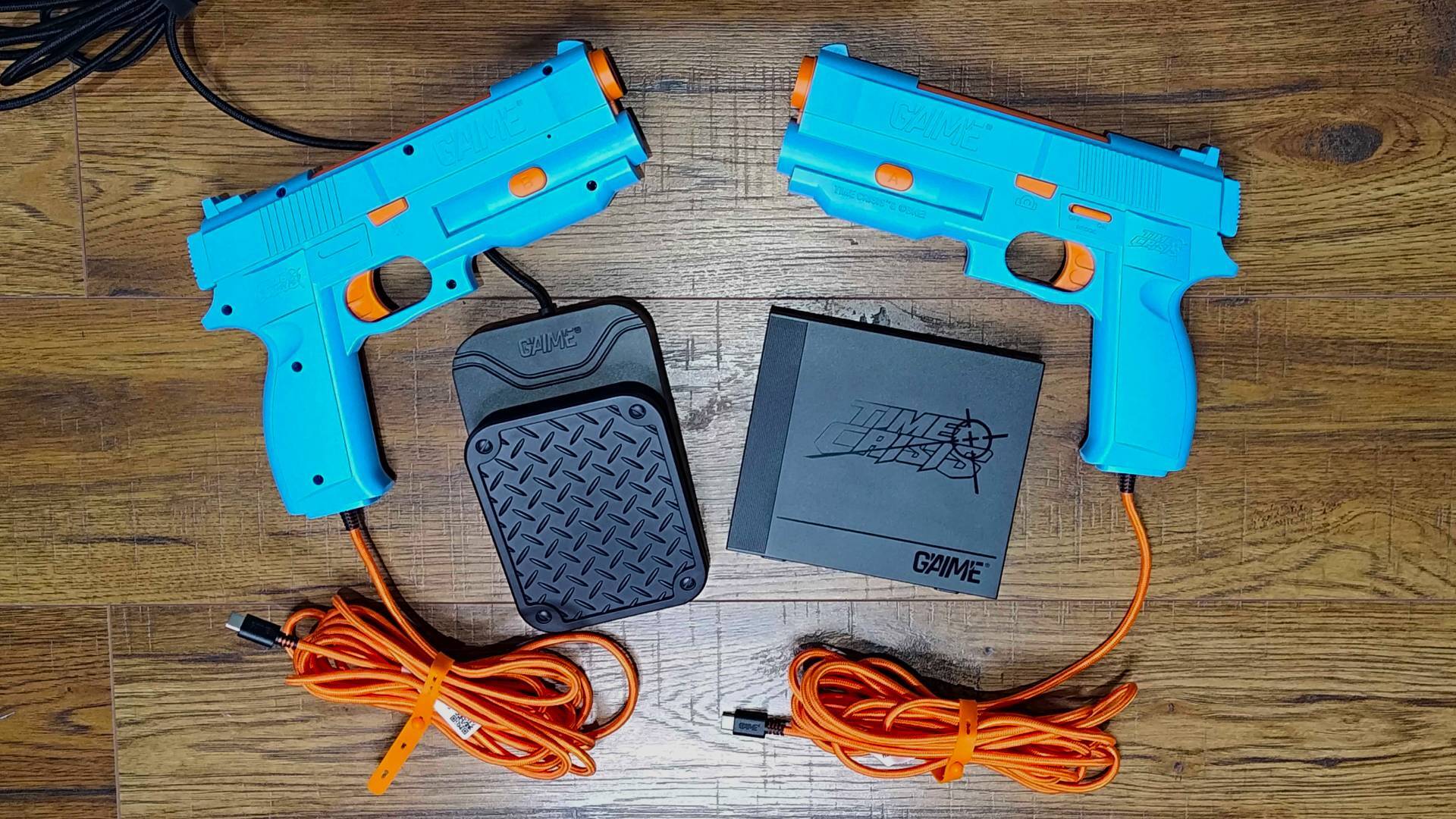
The G’AIM’E Time Crisis Lightgun console is designed with the shooter’s 30th anniversary in mind, but you’re not technically celebrating its birthday with the $99 / £99 bundle. The “Basic” package keeps things low-key by including one USB-C lightgun and the main system itself, with just one game built in.
That’s ideal if you’re solely looking for a quick Time Crisis fix, but for $50 / £50 more, the “Premium” bundle will hook you up with four games (Point Blank, Steel Gunner, and Steel Gunner 2), and an arcade-style reload pedal. You’ll also find a pin badge in the box as a bonus, featuring the “one man army” himself, Richard Miller.
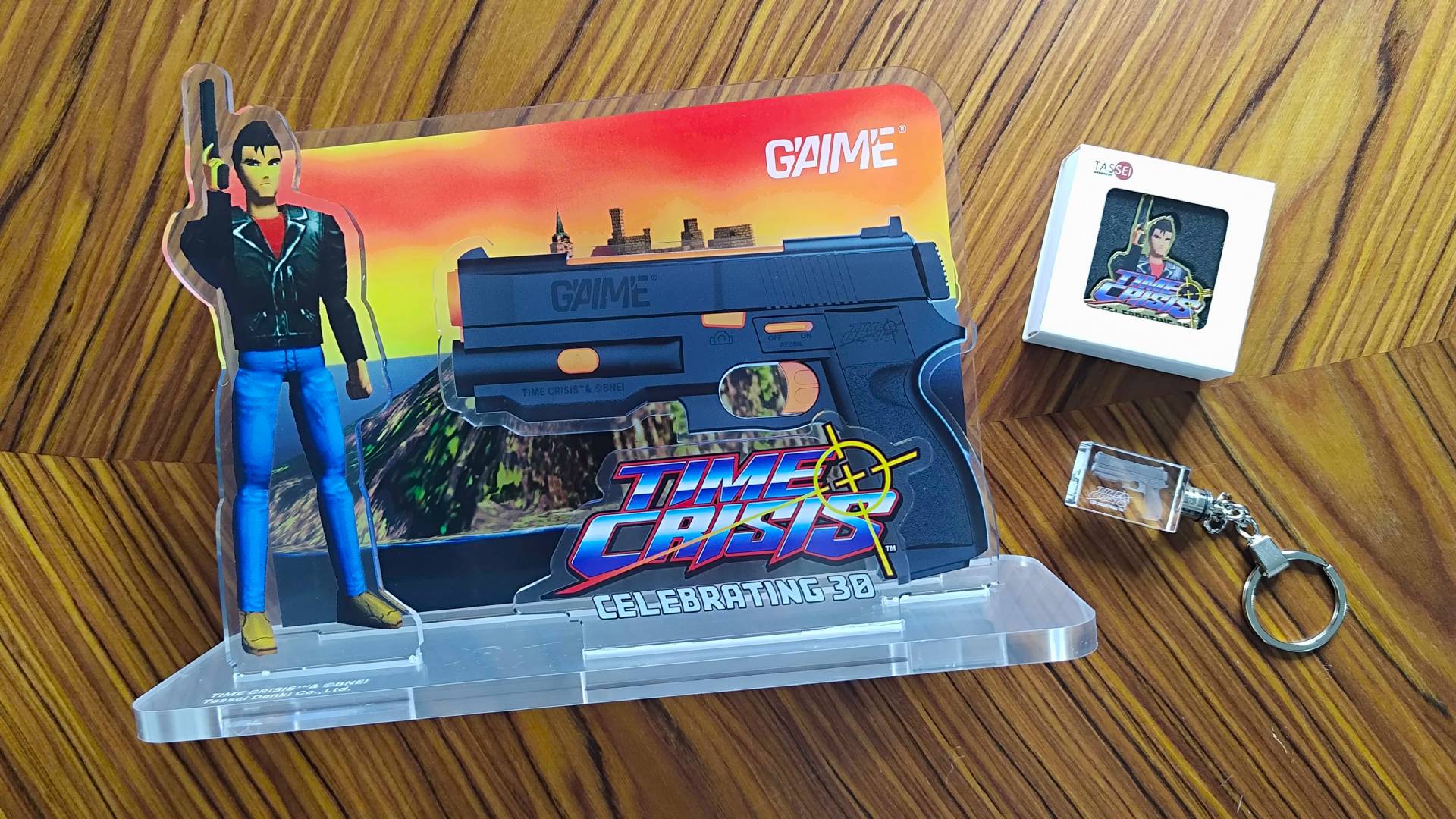
The package I’ll be reviewing specifically is the “ultimate” bundle. For the admittedly lofty price of $199.99 / £199.99, you’ll get an extra lightgun, an acrylic diorama, and everything else included with the premium box. It’s more or less a catch-all solution for those of you who’re a sucker for merch and are looking for multiplayer, but you can pick the guns and pedals up separately if you’d rather start slow.
Design
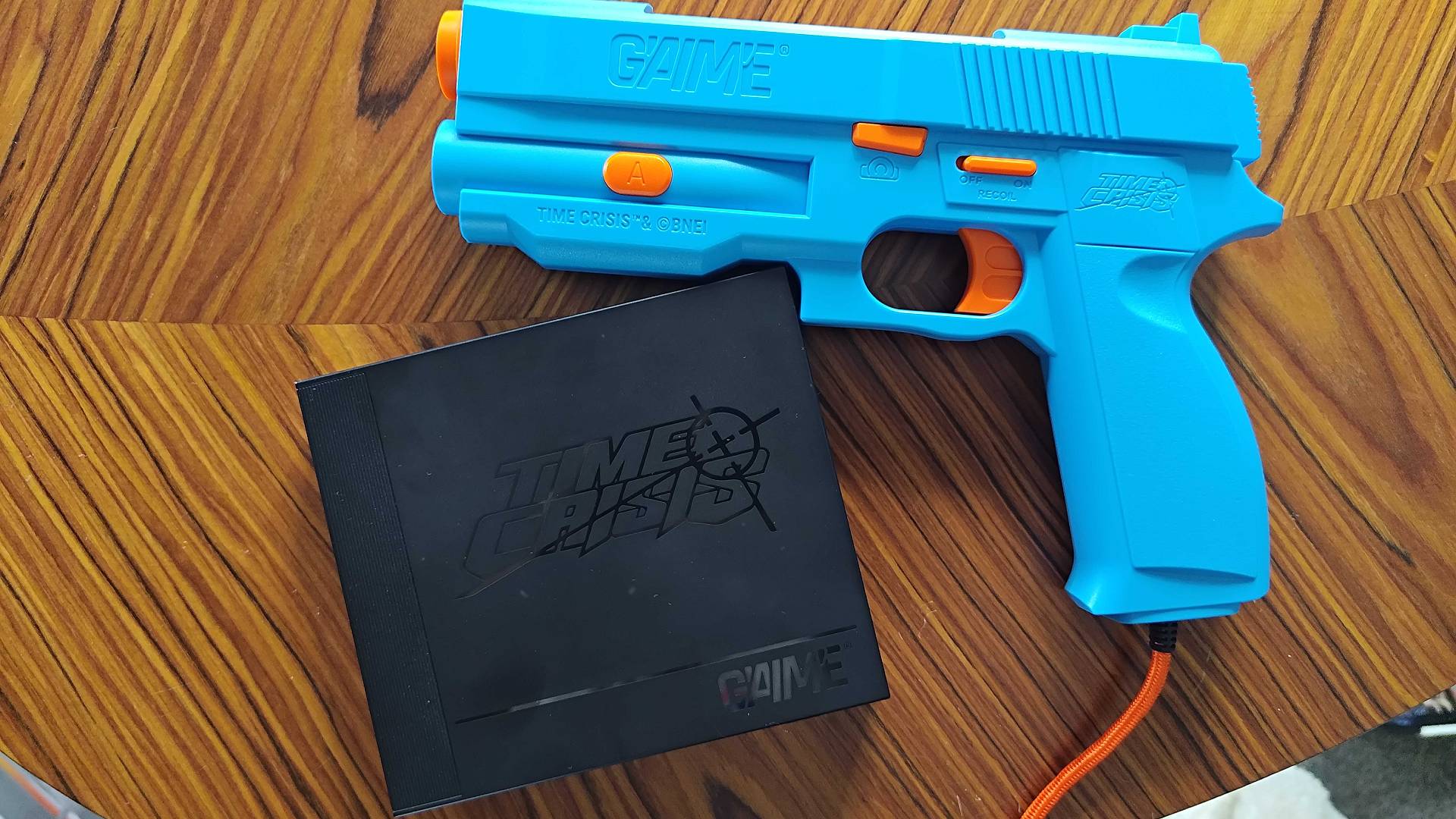
If asked to picture a retro lightgun in your head, I’m willing to bet you’ll end up thinking about the PS1 Namco Guncon. I include myself in that since it’s probably the accessory I’ve spent the most time with, and while the G’AIM’E’s firearms are similar, I don’t think it’s what Tassei Denki Co. or Bandai Namco were aiming for.
Weekly digests, tales from the communities you love, and more
Rather than mimicking a Guncon, the G’AIM’E lightgun actually pays tribute to the original Time Crisis Arcade machine’s firearm. I sadly don’t have access to an original cabinet anymore, and while its sequel is still holding up at my local arcade, its days are probably numbered too. However, the shape of the blue pistols included with this plug-and-play system really holds true to the ‘90s machine, featuring a near-identical grip, trigger, iron sight, and detailing.
Look, it’s hardly a surprise that Bandai Namco went back to its roots for this Time Crisis console. The goal here is to celebrate the game’s 30th anniversary via arcade perfection, so getting the physicality of the hardware right is a natural starting point. Of course, it can’t get away with being an exact copy since it needs more inputs, so you’ll also find a bunch of buttons on the accessory with specific at-home functions.

Those functions include A and B buttons that can be used instead of the optional pedal, a dedicated coin button for squandering fictional moolah, and a settings toggle for navigational purposes. There’s also a sliding on and off recoil switch, but just note that it’ll enable a subtle rumble rather than the same massive clack as the OG arcade guns.
Not using a big old solenoid and metal plunger within does result in these guns being a lot lighter, too. You’ll be gripping onto a 255g firearm when aiming at your TV, and while that is ultimately a good thing when it comes to comfort and practicality, it does mean it feels more like a ‘90s at-home setup rather than a proper relic of the arcade.
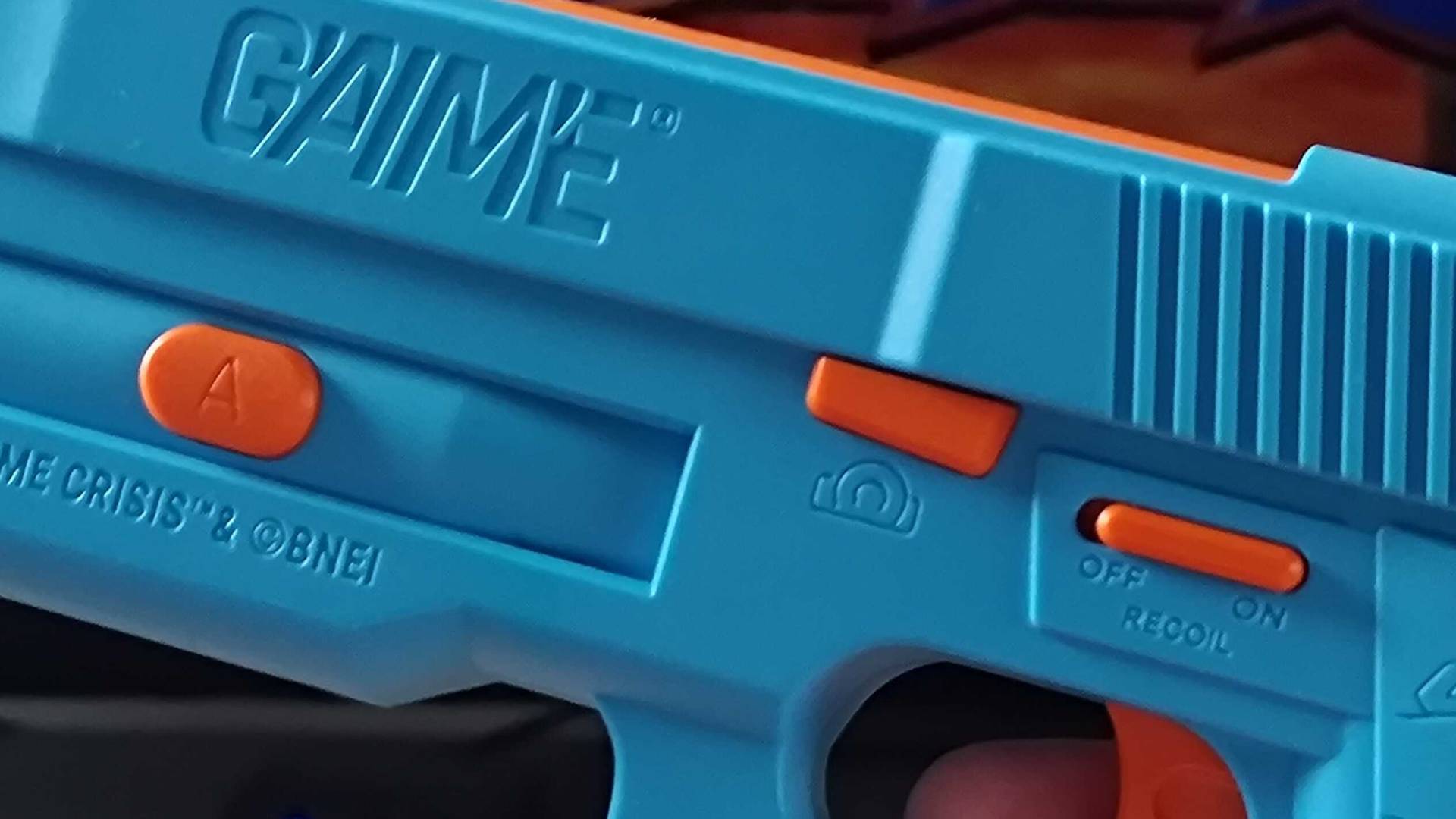
In fairness, regular players won’t want hulking accessories lingering around the house, and the G’AIM’E guns are designed to be stored away easily. The extra-long orange braided cable USB-C folds up nicely with an attached rubber, meaning wrangling it back into its compartmentalised box is nice and easy for travel or just storage.
The gun’s plastic feels pretty nice, with a vibe more similar to a console lightgun than the monstrous heavy-duty pistols chained to ‘90s arcade machines. Keep in mind that those accessories were designed to survive being dropped and rattled against cabinets upon players running out of quarters, whereas the G’AIM’Es weapons should have an easier life. I’d say the shells are strong enough to survive being harassed by younger players, but you’ll want to apply the same care that you would to a conventional controller.
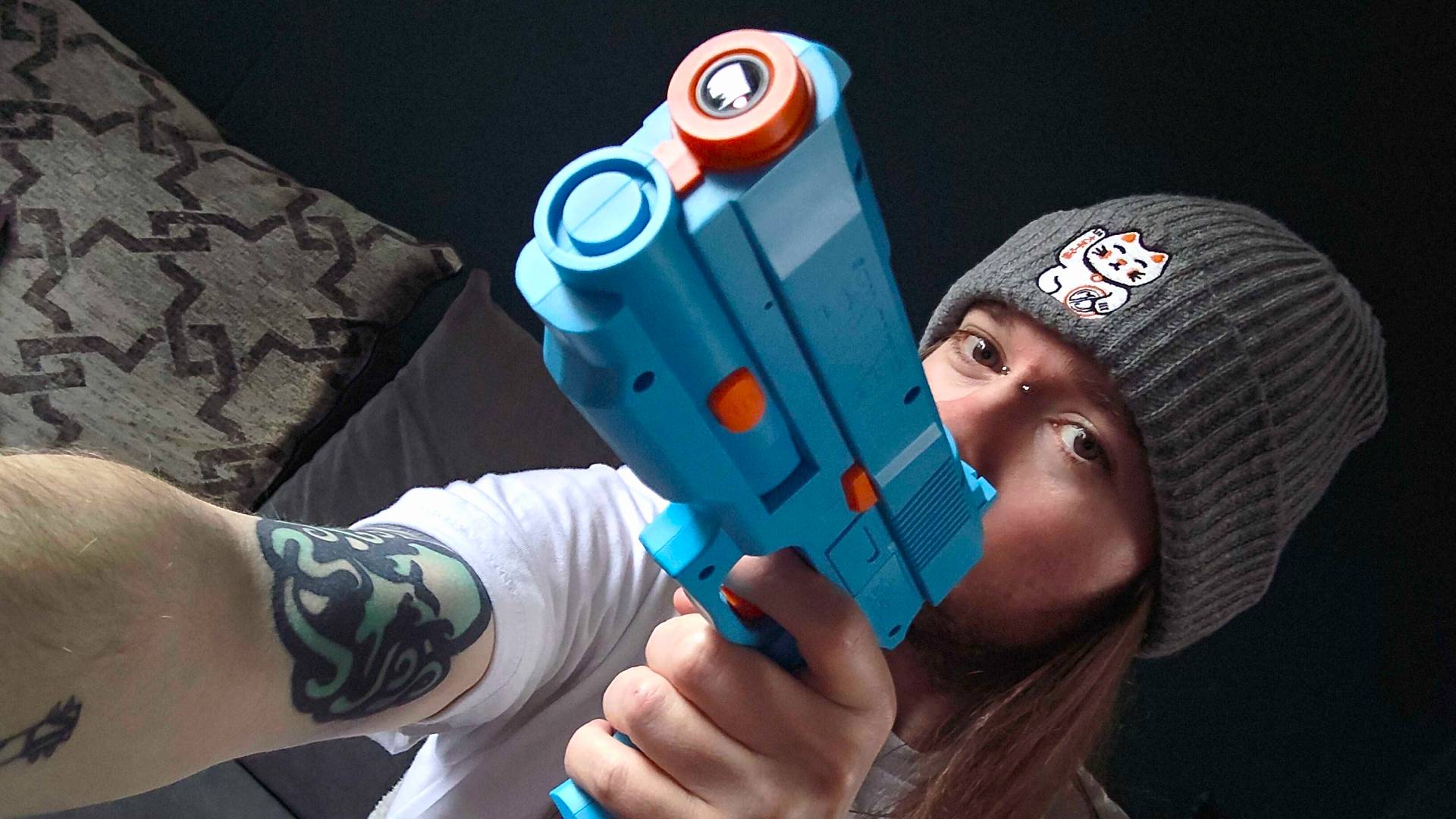
It’s easy to get distracted talking about the G’AIM’E’s lightguns since they’re the star of the show, but I do want to highlight the console itself. At a glance, it’s absolutely an unassuming black box that could easily be mistaken for a basic streaming device or DVR. In fairness, keeping things low profile is probably the right call here, especially if you’re trying not to upset your co-habitants with a convoluted arcade setup, and all you really need is enough space for the essential ports and buttons.
At the front, you’ll find two USB-C ports bang centre for the lightguns and/or pedal. The fact that you’re only getting a pair is a clue to the system’s lack of library expansion options, as you’ll either be using a gun and an optional pedal for Time Crisis or both firearms in Point Blank and Steel Gunner multiplayer sessions. You won’t find any additional ports around the back either, as the rear is occupied solely by an HDMI port and USB-C for power.
As for buttons, you’ve got momentary switches for power and reset at the front. The “On” toggle specifically is a bit mushy for my liking, and it’s hard to get a feel for when the system is actually on. I’ve noticed a few times that the blue light will come on at its own pace rather than when I press, which is slightly frustrating when you’re waiting for an image to hit your TV screen.

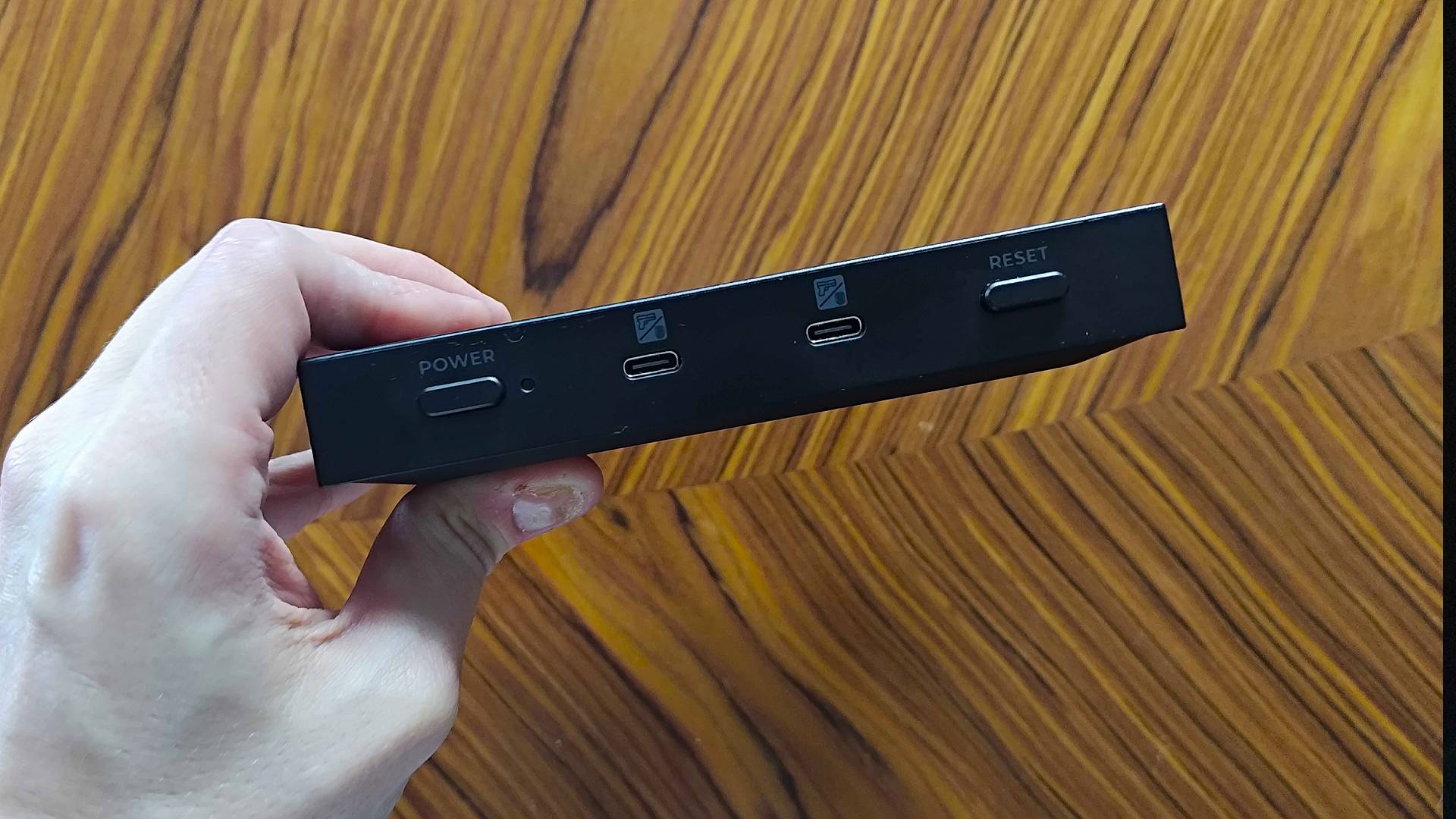
My minor complaints probably make it sound like the box itself does the bare minimum, and that is perhaps the case functionally. But, upon sticking my nerdy eyes up close to the console, I started to notice some really subtle details that are actually a nod to the ‘90s. It took me longer than I’d like to admit to realise that the 142 x 124.5mm box is roughly the same dimensions as a PS1 game case, and the left-hand side even has the same spine ridges next to the engraved Time Crisis logo.
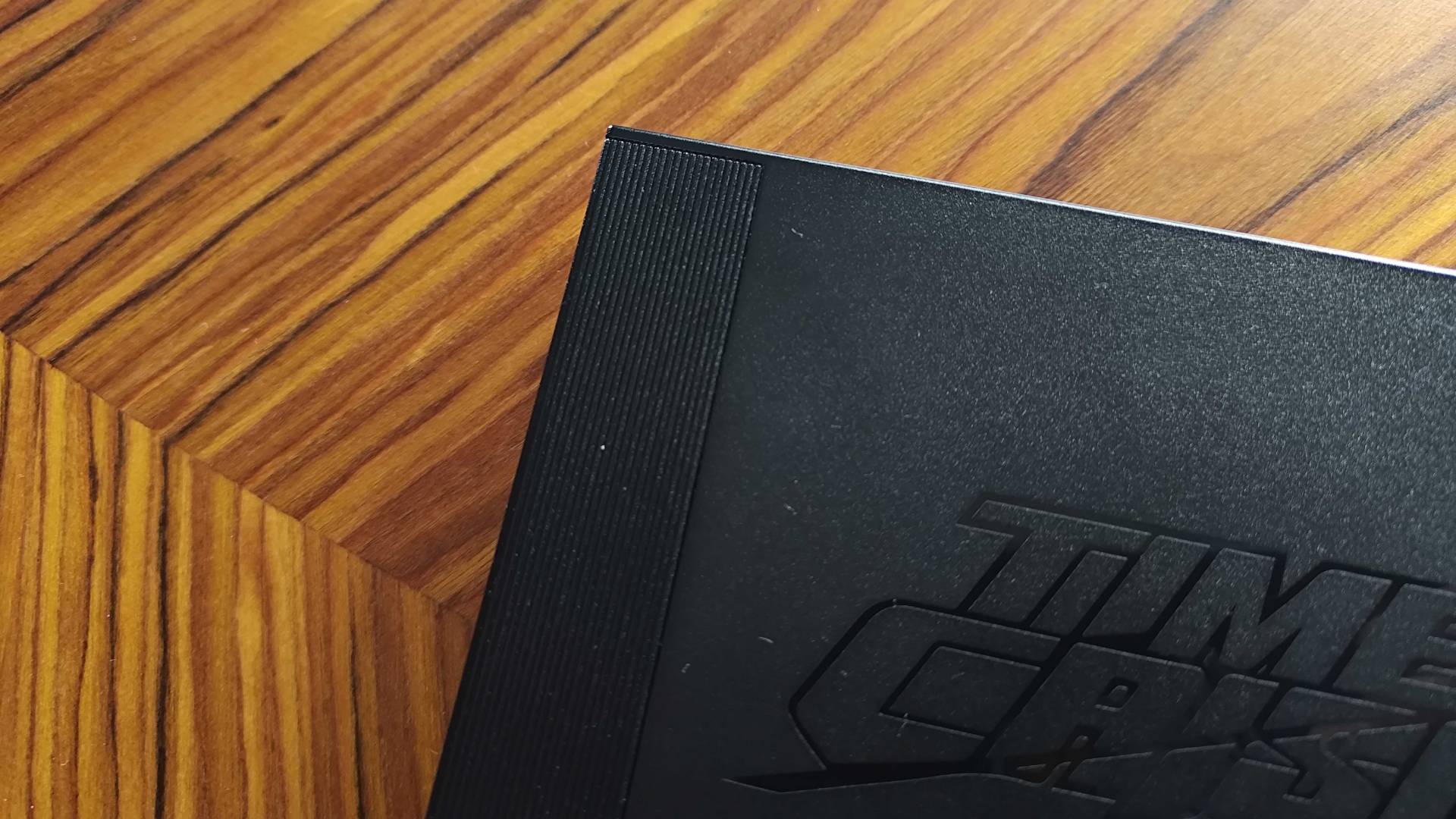
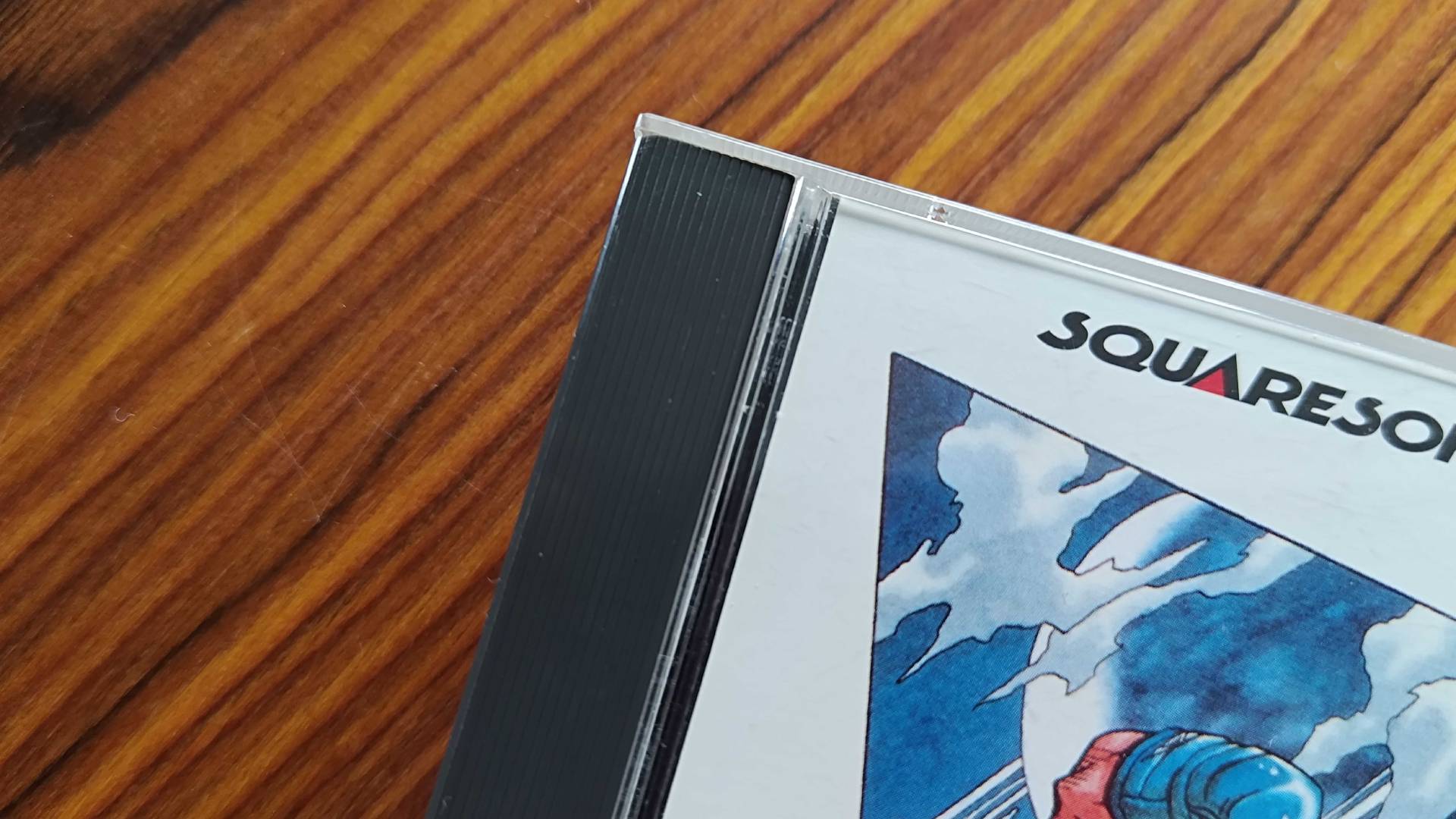
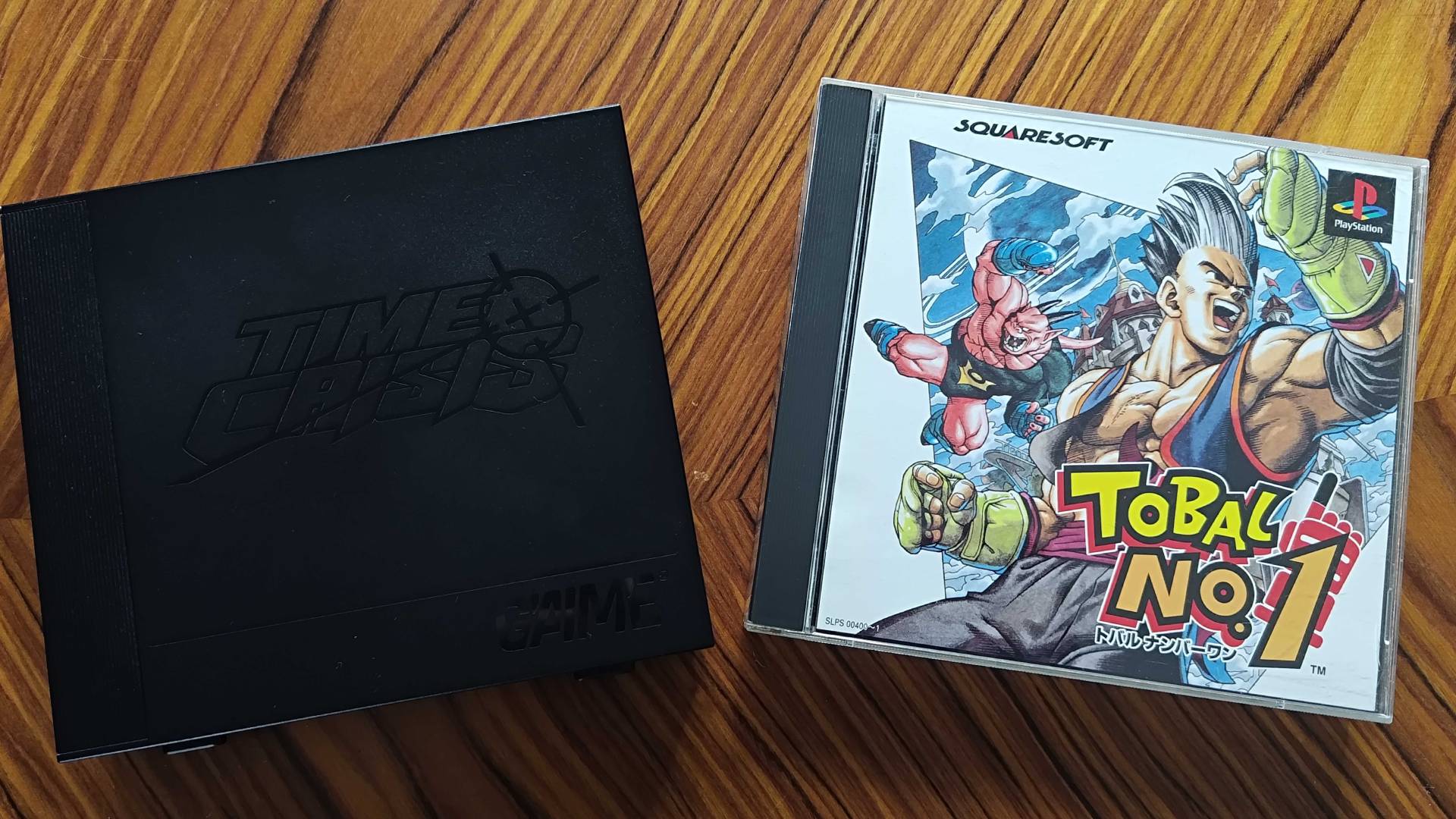
This is a really nice touch that makes the box itself sort of more collectible, but I am curious about the intention behind the reference. I don’t want to get ahead of myself; however, I am wondering if G’AIM’E is envisioning releasing new boxes for different series in the future. Circling back to pricing, the most expensive part of the set is the lightguns themselves, and theoretically, another system with different games on it could cost around $40. If this is the plan, I sort of wish they’d leaned more into the box design idea with actual colorful artwork for collectability reasons, but alas, I’m perhaps getting the wrong idea.
The last item in the Ultimate bundle box that actually matters to gameplay is the pedal. It’s serviceable, if not slightly smaller than I was expecting before getting hold of it, but that doesn’t really impact usability. It’s certainly not the same approach as the big original metal pressure plate designed to be stomped the hell out of in a busy arcade hall, and instead is more angled up for those of you on the couch.

You can use it on your feet too, though, and it’s got some rubber pads at the bottom to stop it sliding on floors. What I will say is that it’s fairly light and plasticky, so I’d perhaps lay off the stomping and use the pivot with your foot arch with reasonable pressure. It’s not going to feel quite like OG arcade Time Crisis since the idea was that you’d step out of fire to reload rather than press an accelerator-like pedal, but hey, the setup is still achieving the same goal.
Features
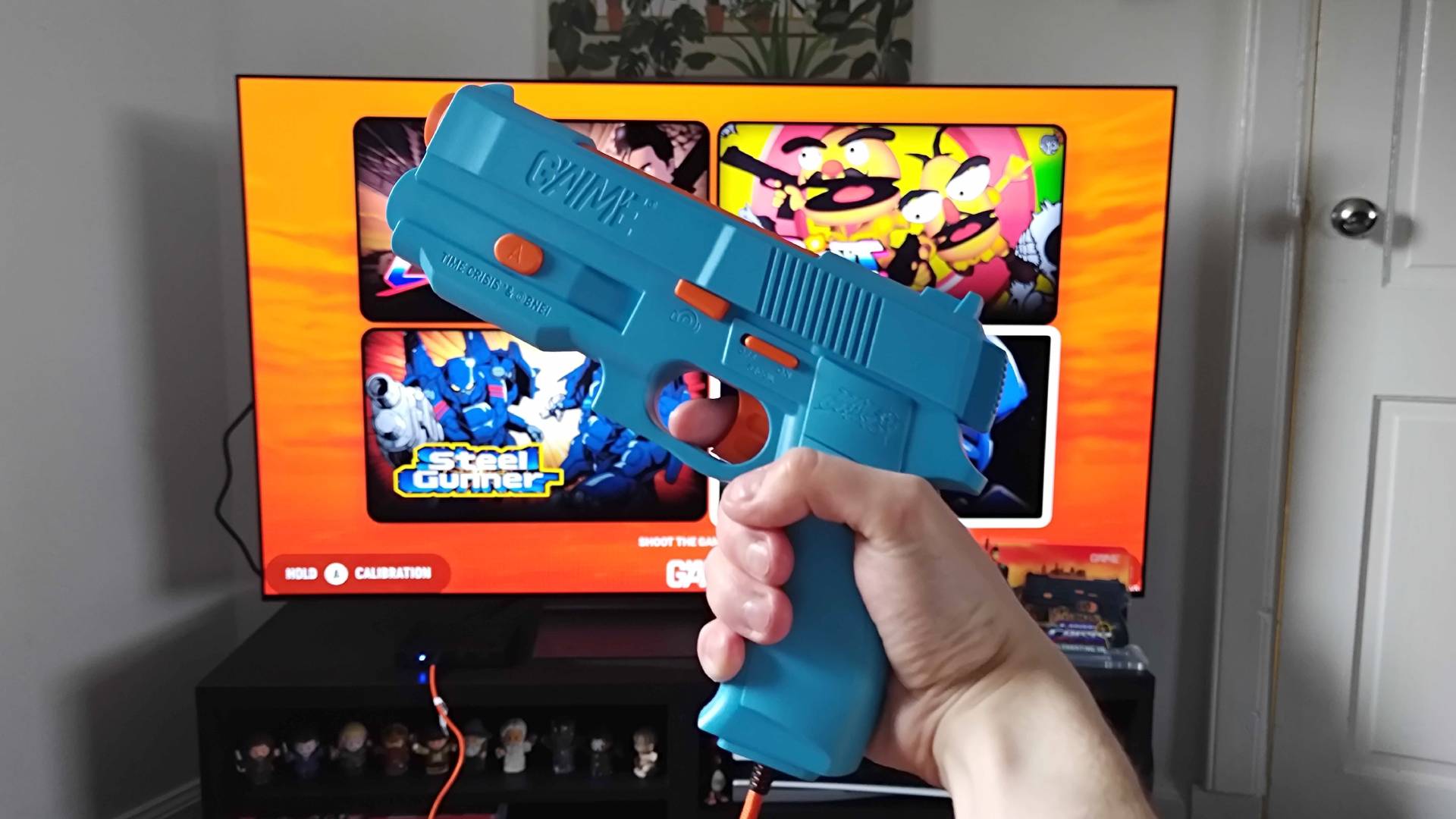
Taking lightgun technology for granted is exactly why the genre now requires a revival. No one specifically decided to stop making shooters like Time Crisis, and the demise of the format is tied to the switch from CRT TVs to incompatible LCD displays. Simply put, if you want to shoot down baddies on a screen in 2025, you’ll need a gun that can actually see what’s happening, and Tassei Denki Co. has conjured up an affordable solution.
Not to be pedantic, but this console technically isn’t using lightguns. By that, I mean there isn’t a photodiode light sensor hiding down the barrel waiting to see a white box on a black backdrop upon pulling the trigger. This is all something that’d happen quicker than the human eye can detect with old setups, producing a faux effect of bullets hitting the screen.
Rather than trying to make that somehow work on new screens with different refresh rates and specs, G’AIM’E has opted to use a combination of high-resolution cameras, gyroscores, and AI chips to track what’s happening on your TV. The lightguns can effectively see what’s happening on your display and calculate coordinates so it knows where you’re shooting, which feels a bit like a more sophisticated magic remote cursor.
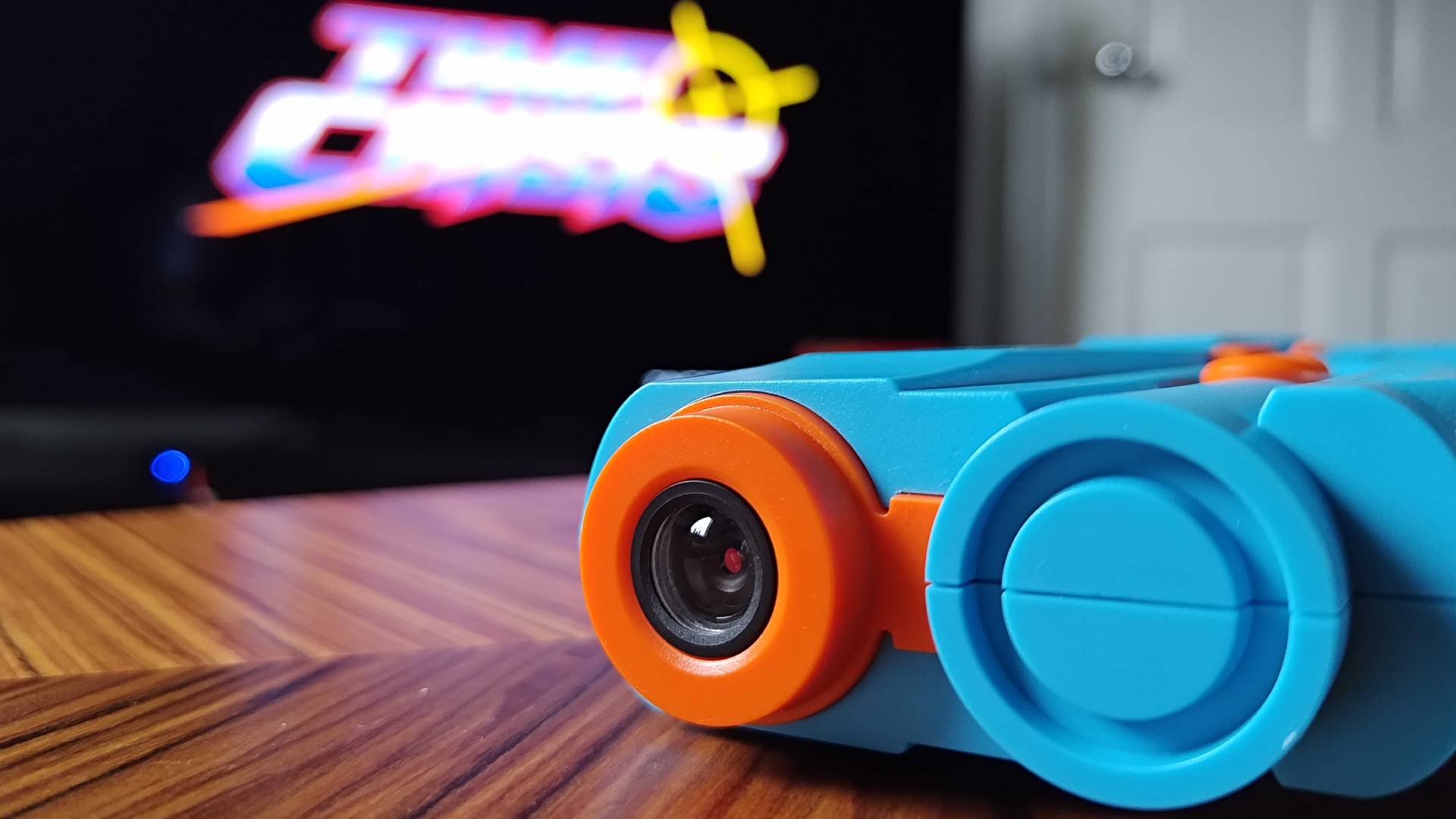
Yes, my back was initially up at the mention of AI too, but it’s not exactly what you’d think. The tech is seemingly being used to save the need for additional TV sensors or borders, as the guns are instead trained to know where display edges start and end. That does save the need to use any weird extras to dial in your playspace, but you’ll still need to use on-screen calibration targets (I’ll get to that in a bit).
Of course, this isn’t a completely original idea by G’AIM’E, as the mighty Sinden Lightgun has been rocking a similar camera sensor for about five years now. The Guncon-inspired PC controller uses a pretty similar approach to translate shots towards your screen into inputs, but is absolutely geared more towards enthusiasts who are more willing to tinker with emulators and settings. It also relies on a white on-screen border around whatever you’re playing, whereas Tassei Denki Co. is seemingly using AI to avoid that.

As always, hardware is only half the story, and the kind of authentic Time Crisis experience G’AIM’E promises also relies on good software. For what it’s worth, the console’s creators are clearly invested in making sure you get to play the shooter properly without any snafus, going as far as to include a whole tutorial introduction whenever you switch the box on.
That is slightly comical, seeing as you’re immediately hit with a setup one-pager upon unboxing the G’AIM’E detailing all the dos and dont’s. The video intro more or less touches on the same info about distances from screens, being near bright reflecting lights, and making sure you actually use the calibration screen properly. You can thankfully skip the intro if you’ve already switched the box on, which will let you zoom past everything to the main game screen.
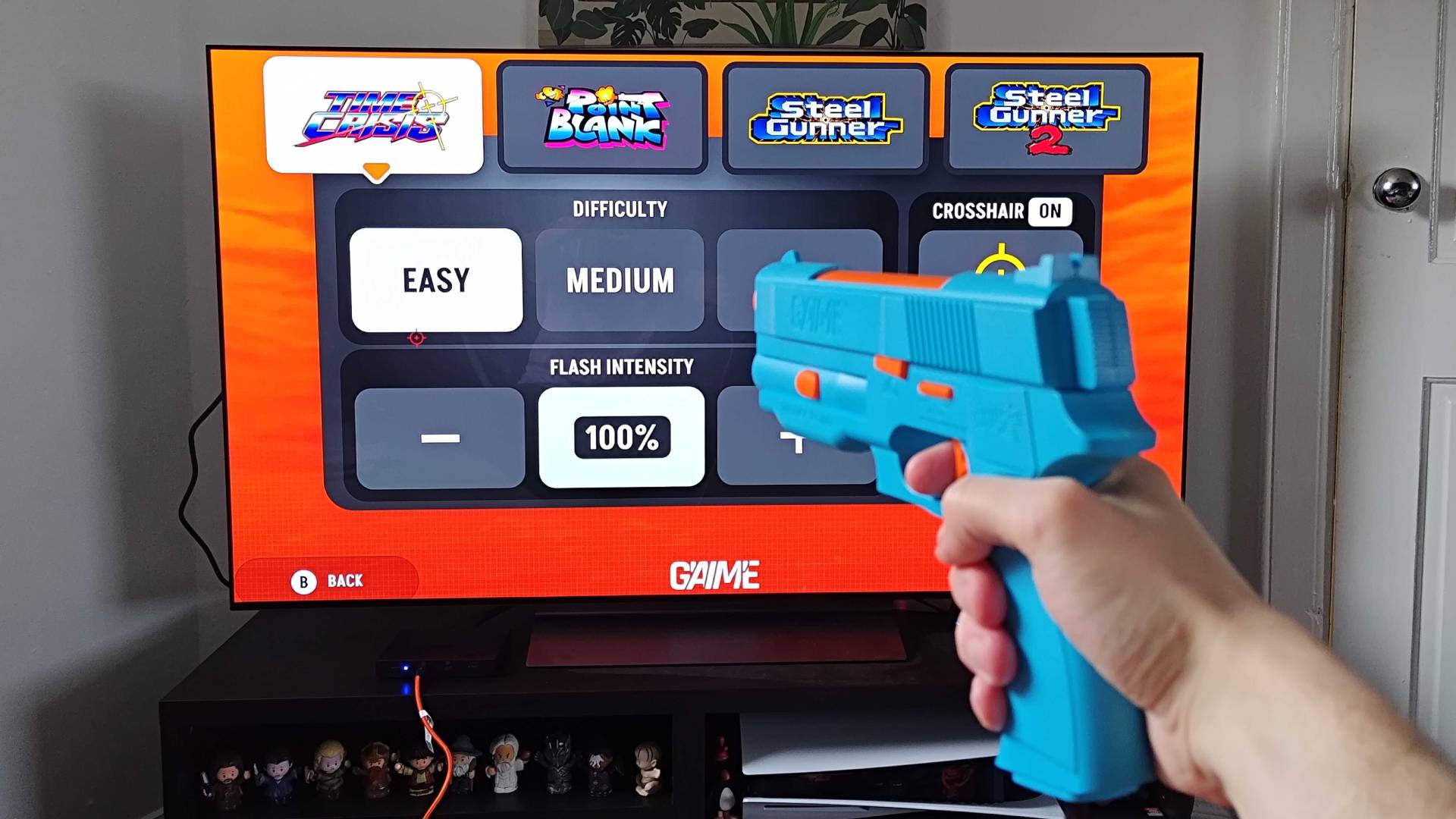
The main game menu keeps things extremely simple with a four-box library grid, a left A-button prompt to re-enter the calibration screen, and a B-button option on the right for the settings screen. I presume that if you go for the version with only Time Crisis, you’ll be greeted with just the shooter on this page, but I can’t comment on whether there’s a UI change.
Jumping into each game should be as simple as shooting each square. I say should be, as this is how you find out if you messed up the initial target-based calibration. If you did everything right, though, then you’ll see a white highlight around each selection as you point the gun, which serves as a reassurance that you’re actually pointing at your desired box before firing.
In the settings menu, you’ll find a couple of options tied to each game. Time Crisis has the chonkest selection since it provides difficulty modes (easy, medium, and hard), a flash intensity percentage gauge, and the option for a visible on-screen crosshair. That matter reticule serves as a cursor for the main menu too, which actually somewhat remedies my previous navigational gripe.
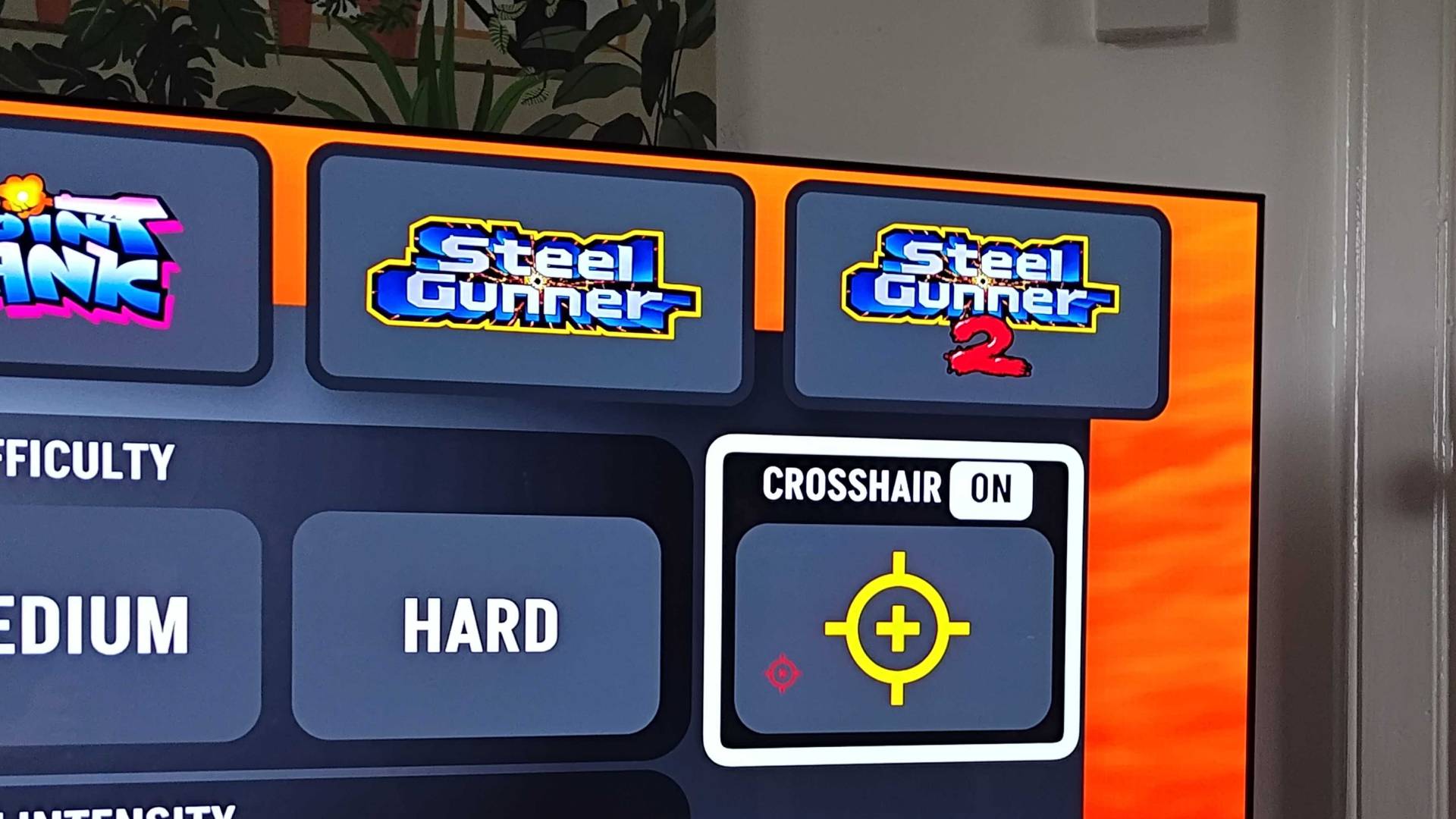
I do feel like the G’AIM’E console’s settings menu is pretty underwhelming, especially since it avoids including any visual options whatsoever. I’m not saying I want to be tweaking things in the same manner as an emulator, but I would have enjoyed seeing effects like CRT filters and scanlines included. Those graphical options would have added an extra immersive edge for nerds like me who still use old TVs, but perhaps they would have messed with the lightgun’s accuracy in some way (I doubt it, but it sounds like a plausible excuse).
Performance
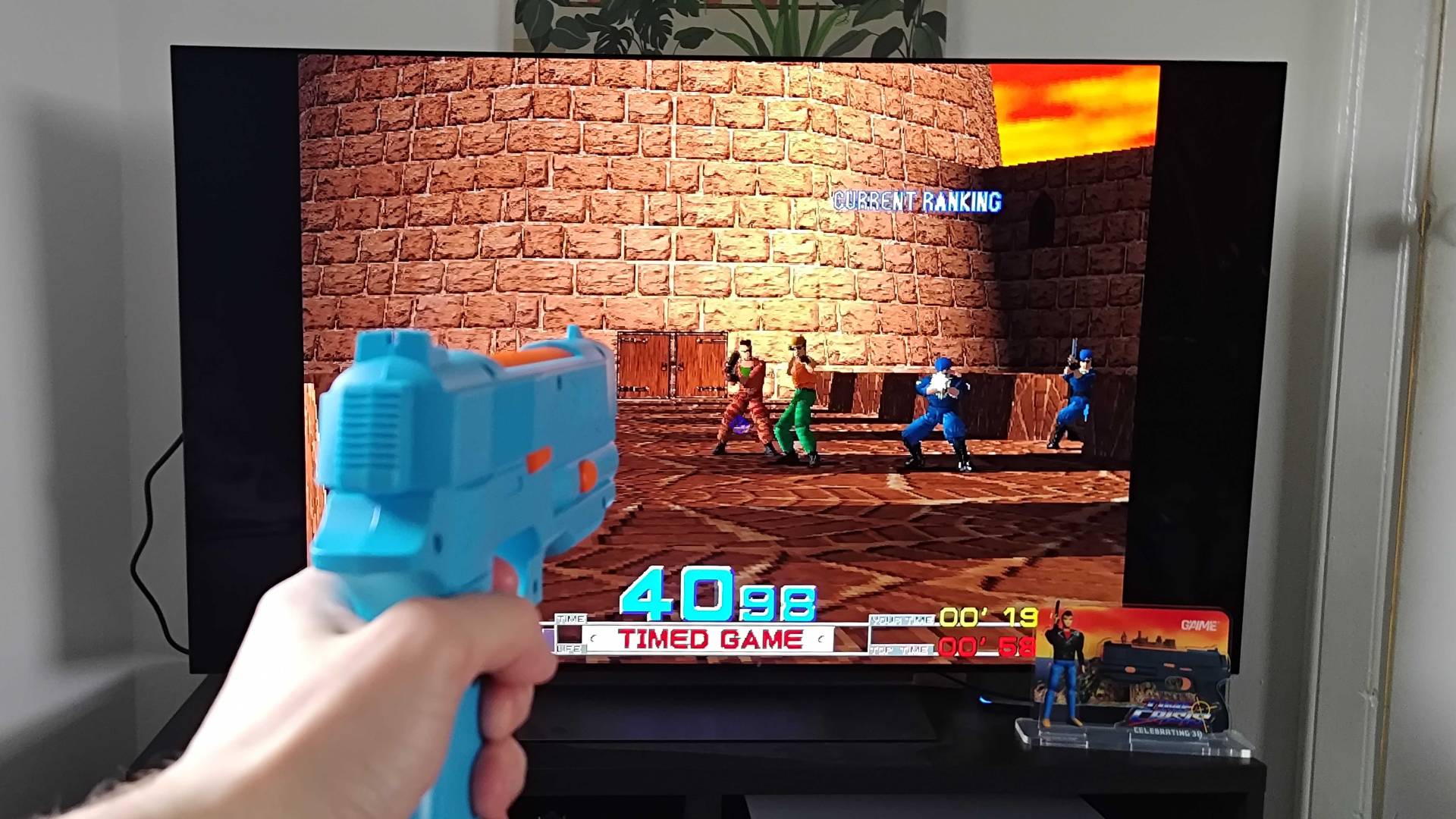
In my mind, the G’AIM’E Time Crisis console has two mandatory objectives: provide comparable accuracy to the original arcade machine and ensure the game runs the same way too. After spending a chunk of time comparing the system’s gameplay to both the Sinden Lightgun and my years of experience using ‘90s cabinets, I’m pleased to report it succeeds on both fronts, albeit with a few niggles.
I’ll get some of my non-gameplay grips out of the way first, as they tie to the very first thing you’ll see - the dreaded calibration screen. I’m not completely adverse to using processes like this, and the instructions do make it clear that you should carefully aim for each target using the iron sight to ensure the best results. The part that gives me the ick is that it’s seemingly not a one-and-done thing, as you’ll be prompted to do it every time you switch the console on.

I wouldn’t say having to calibrate every time you switch on is an absolute deal breaker, but I’m not sure why it doesn’t save the results for your specific TV. I suspect it’s because different lighting levels and other factors will throw the guns off, regardless, and recalibrating could be a way to prevent that from being a recurring issue. Still, presenting the player with the same first startup tutorial intro every time feels a bit weird, almost like it’s expecting you to forget how to use the system between sessions.
Your specific TV isn’t the only thing the G’AIM’E will forget, as it won’t save settings either. Upon powering off and on, you’ll notice that your visible crosshair is no longer enabled, so it’s back into the menu with you to turn it back on. This really only impacts those of you who prefer to play with a target on screen, something that technically isn’t an authentic Time Crisis option. Nevertheless, if you’re planning on using the system regularly, even two-second tweaks like this could get tedious.
Thankfully, the G’AIM’E console’s actual lightgun gameplay makes up for these small quirks. For the most part, taking down goons in Garo Castle feels nice and accurate, with each shot landing true. I actually spent a chunk of time using the optional crosshair just to check that my aim wasn’t being messed up by sensor shenanigans, and while it revealed just how unsteady my shooting hand is, it also confirmed that the calibration wasn’t way off.
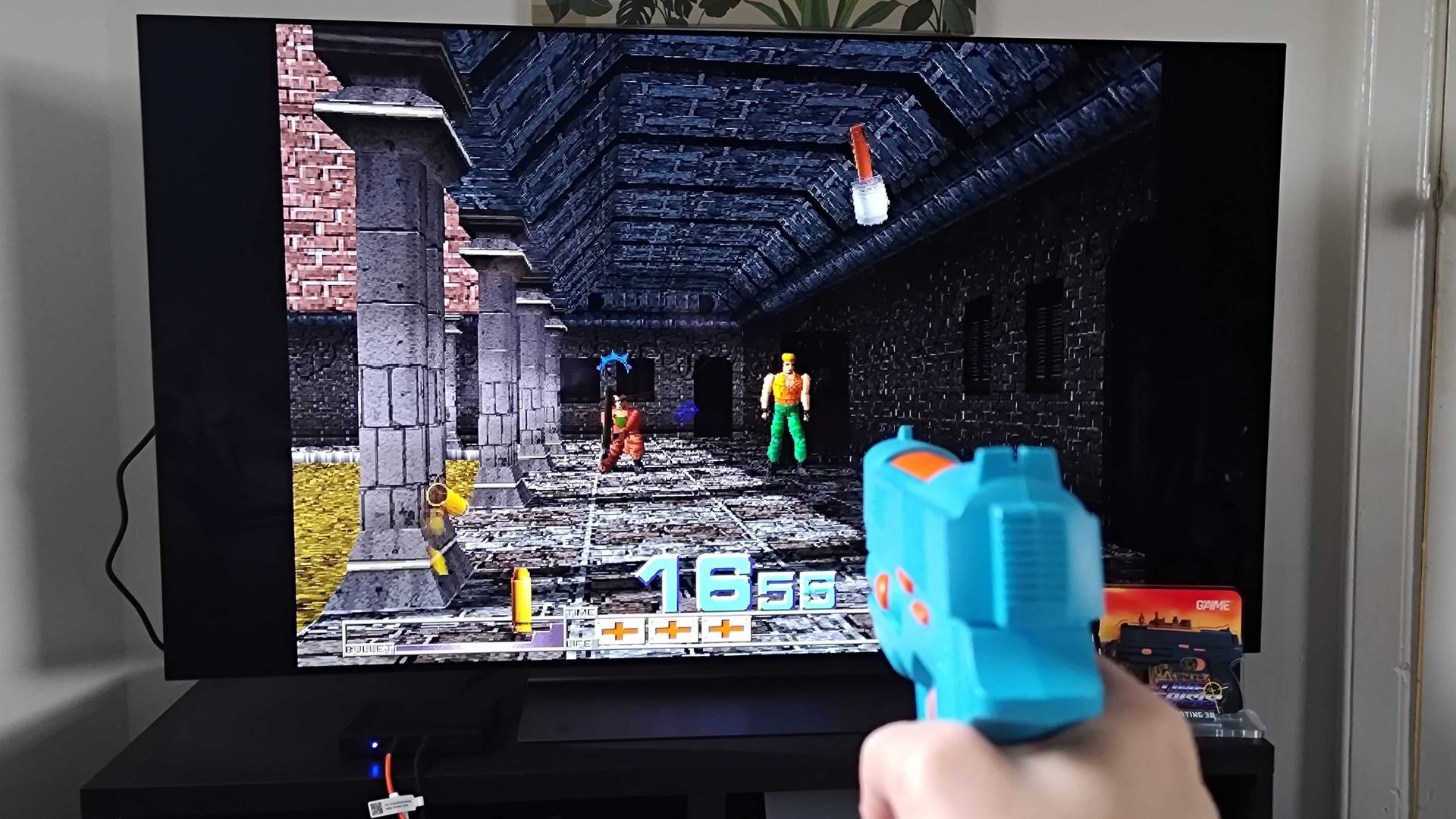
I’m also pretty pleased with how the G’AIM’E pedal feels, especially since it’s not quite the same as the arcade machine’s big metal pad. I was able to easily duck and reload by releasing my foot, both sitting down and on my feet, but the latter did take me longer to get a feel for. The gameplay loop still very much sent me back to my days shoving coins into the cabinet at my local theme park, even if I’m nowhere near as skilled as 8-year-old me.
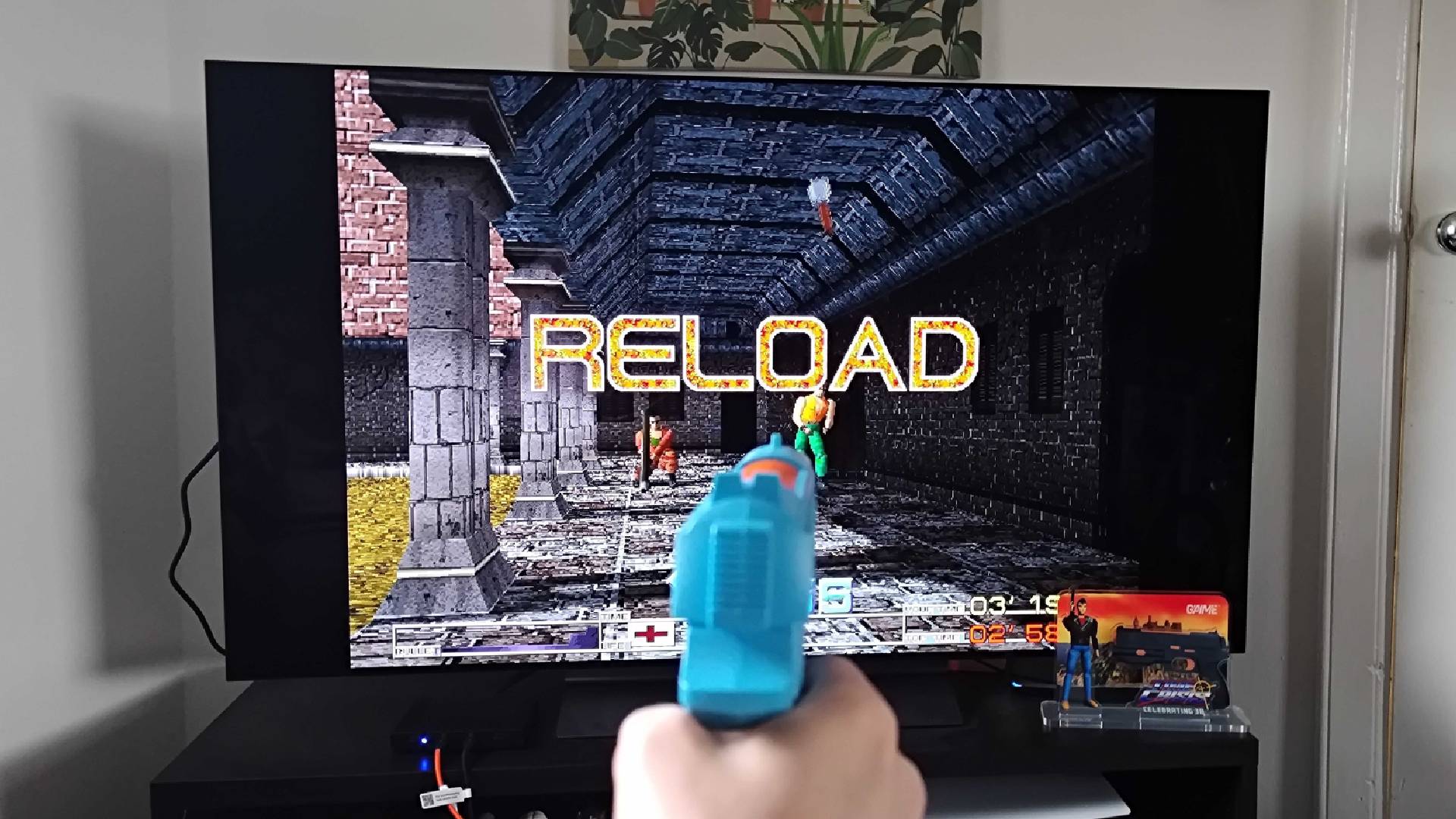
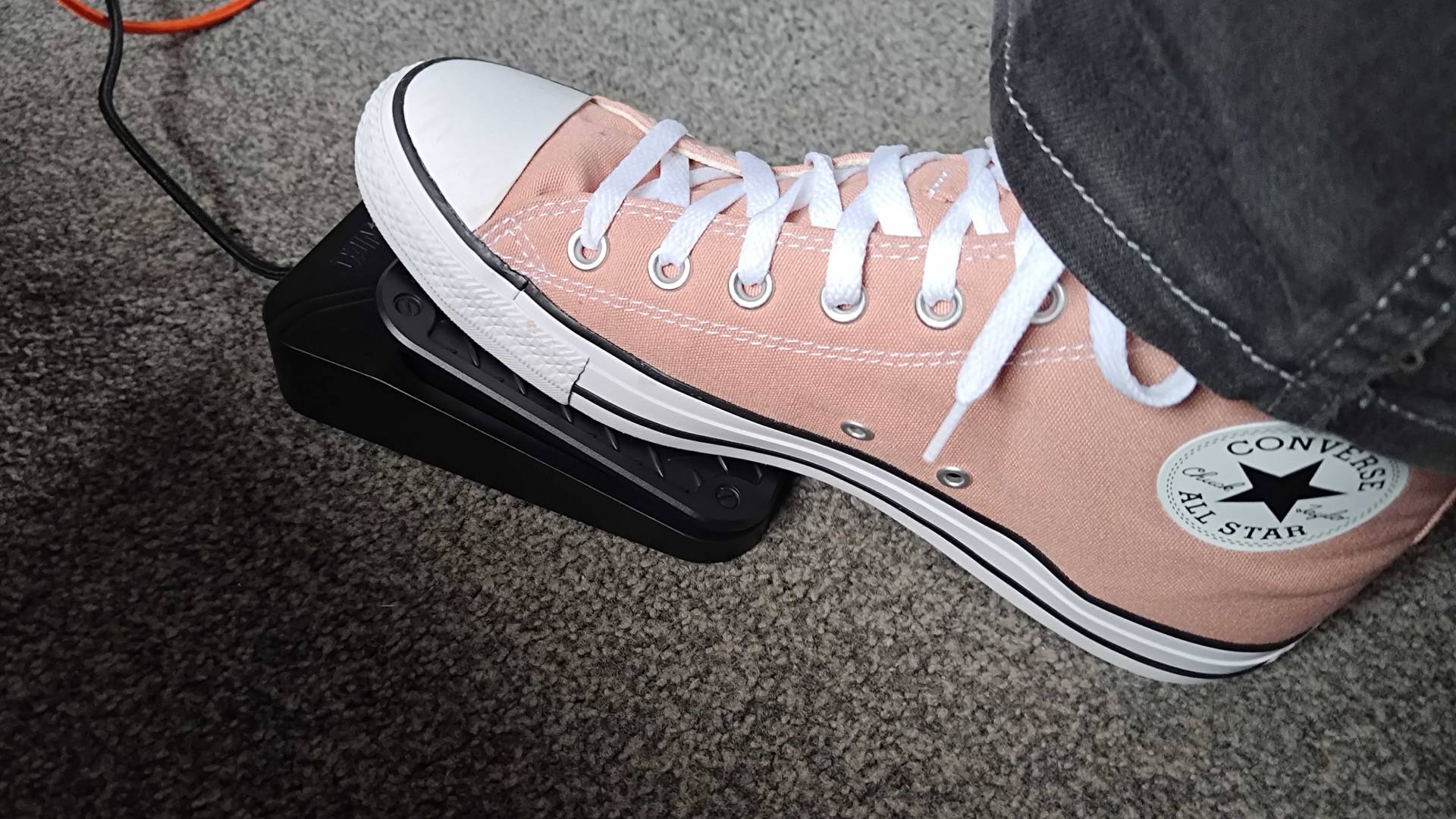
If I’m being real with you, I feel like I almost forgot how you’re actually meant to play Time Crisis. If you want to actually land some precise shots, the best approach is to hold the pistol with both hands and make good use of the iron sight. Otherwise, the terrorists you’re shooting will end up having a Pulp Fiction-inspired Divine Intervention moment.
The G’AIM’E guns feel particularly sensitive compared to the Sinden lightgun, which actually feels a bit more true to the arcade experience, even if it makes you feel less cool. Basically, unless you’re Solid Snake after a cigarette levels of steady, I’d forget about trying to be gangsta with a side grip (or at least get a bit of practice in first.)
Visually speaking, the G’AIM’E console’s Time Crisis port is solid, boasting crisp visuals at 1080p. Rather than using emulation, this version has been rebuilt from scratch using the original arcade ROM. That’s not to say running it yourself through something like MAME won’t produce the same results, but I did notice that without any settings tweaks, the colors looked a bit richer on Bandai Namco’s new version.
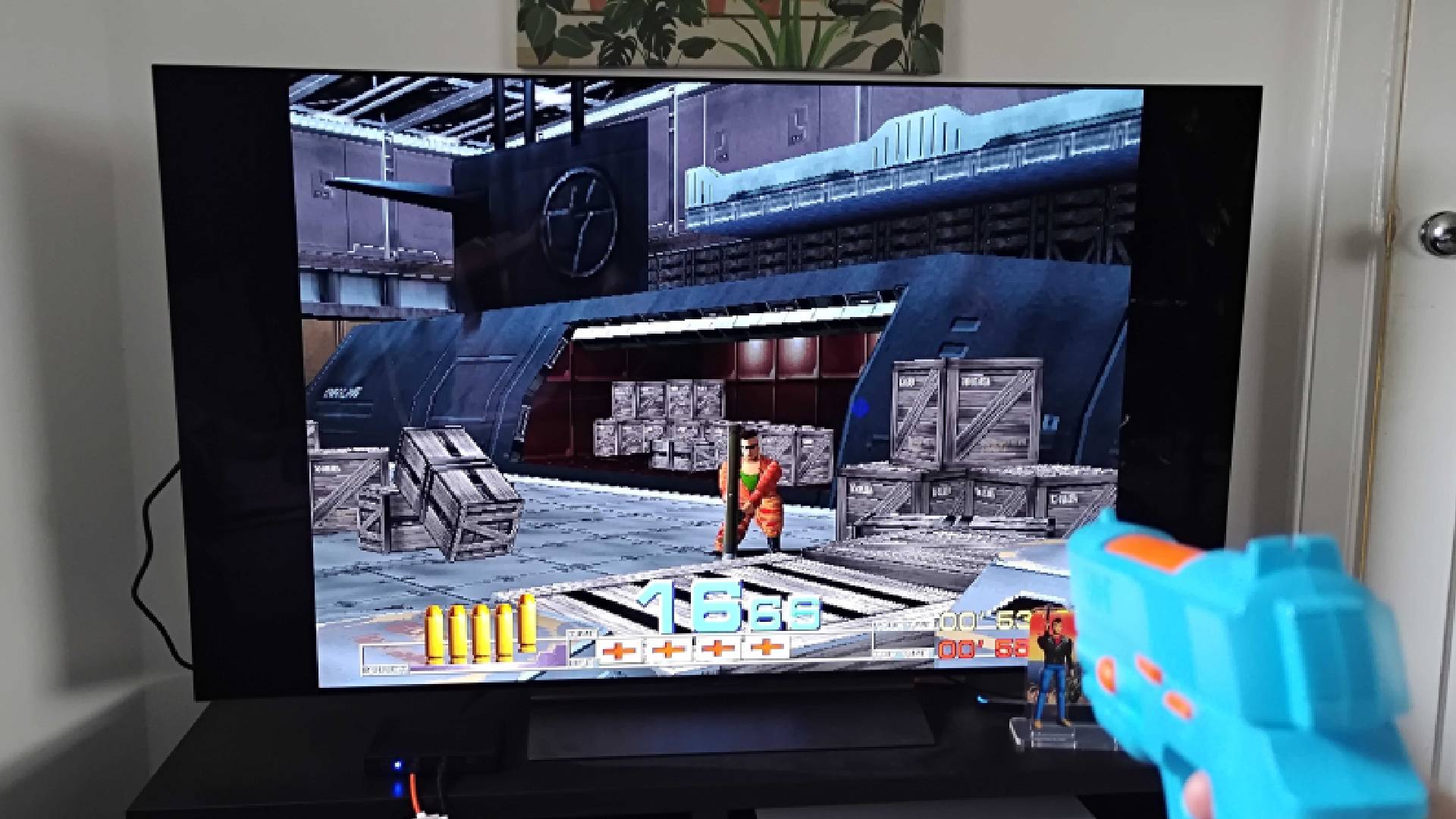
Circling back to the lack of settings, I do think the option of scanlines would have been a visual cherry on top. Without pixel separation, enemy sprites do look a little bobbly, and while that’s basically just a symptom of any 3D game on a modern screen, a basic overlay could have enhanced definition a little. I am actually trying to get hold of a separate scanline generator for HDMI consoles, so I may end up hooking it up to the G’AIM’E console just to see if it works down the road.
While they’re not the star of the show, it’s worth talking about the other three games included with the Premium and Ultimate bundles too. Point Blank is a pretty nice, casual edition that works well as a multiplayer party game, and like the name suggests, having bad aim is part of the fun. You’re talking a bunch of chaotic mini shooting range games that feel very reminiscent of Bishi Bashi Special and Wairoware, which isn’t quite as serious as fighting functional terrorists.
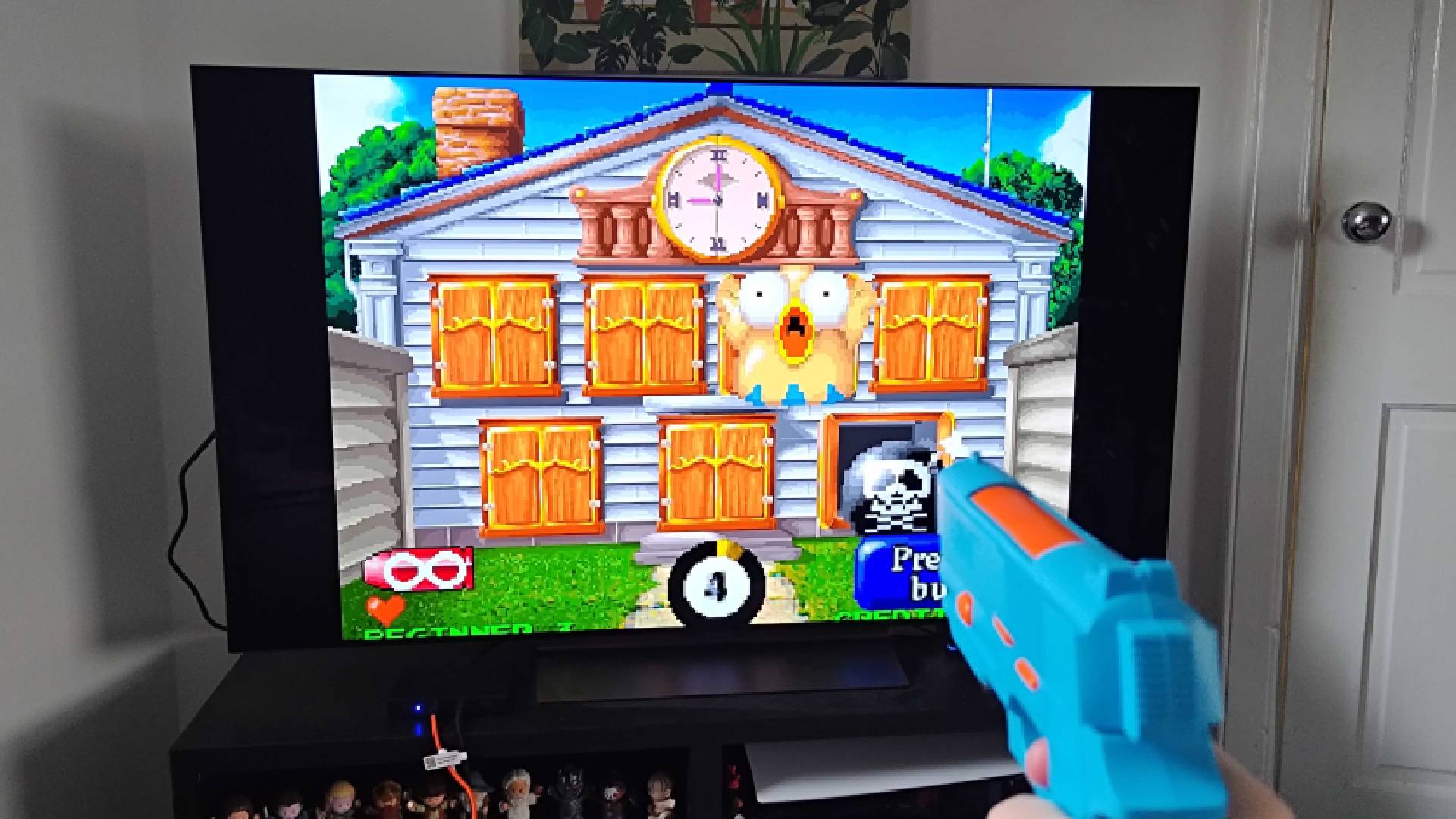
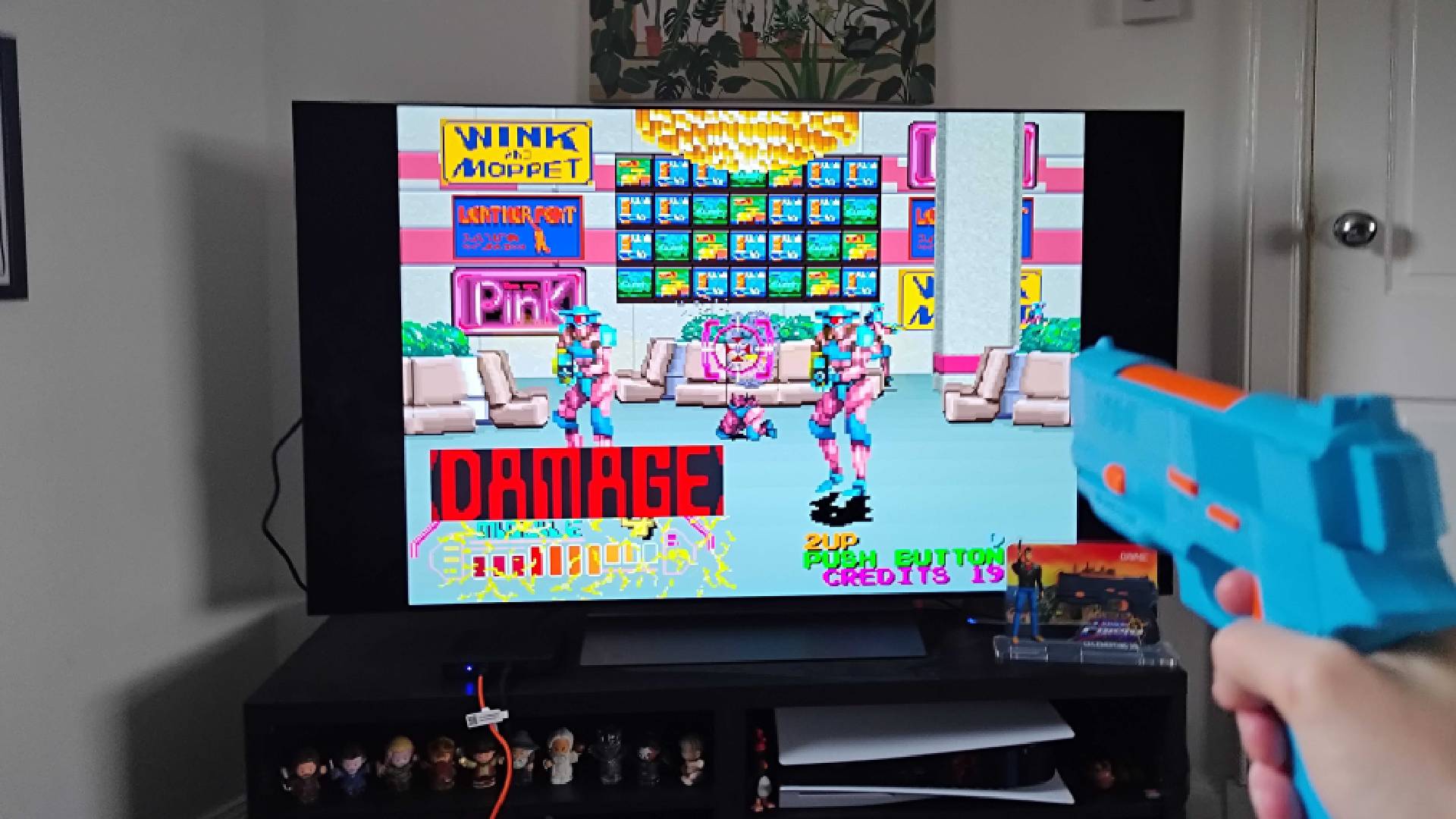
You’re also getting Steel Gunner 1 and 2, both of which I’m pretty unfamiliar with. The original was actually Namco’s first lightgun game, so including it in an Anniversary console like this makes sense. As far as I can tell, both run as they should without any graphical glitches and maintain the same accuracy as Time Crisis, but I am wondering whether we really needed the sequel since they’re pretty similar-feeling shooters.
Should you buy the G’AIM’E Time Crisis Lightgun console?
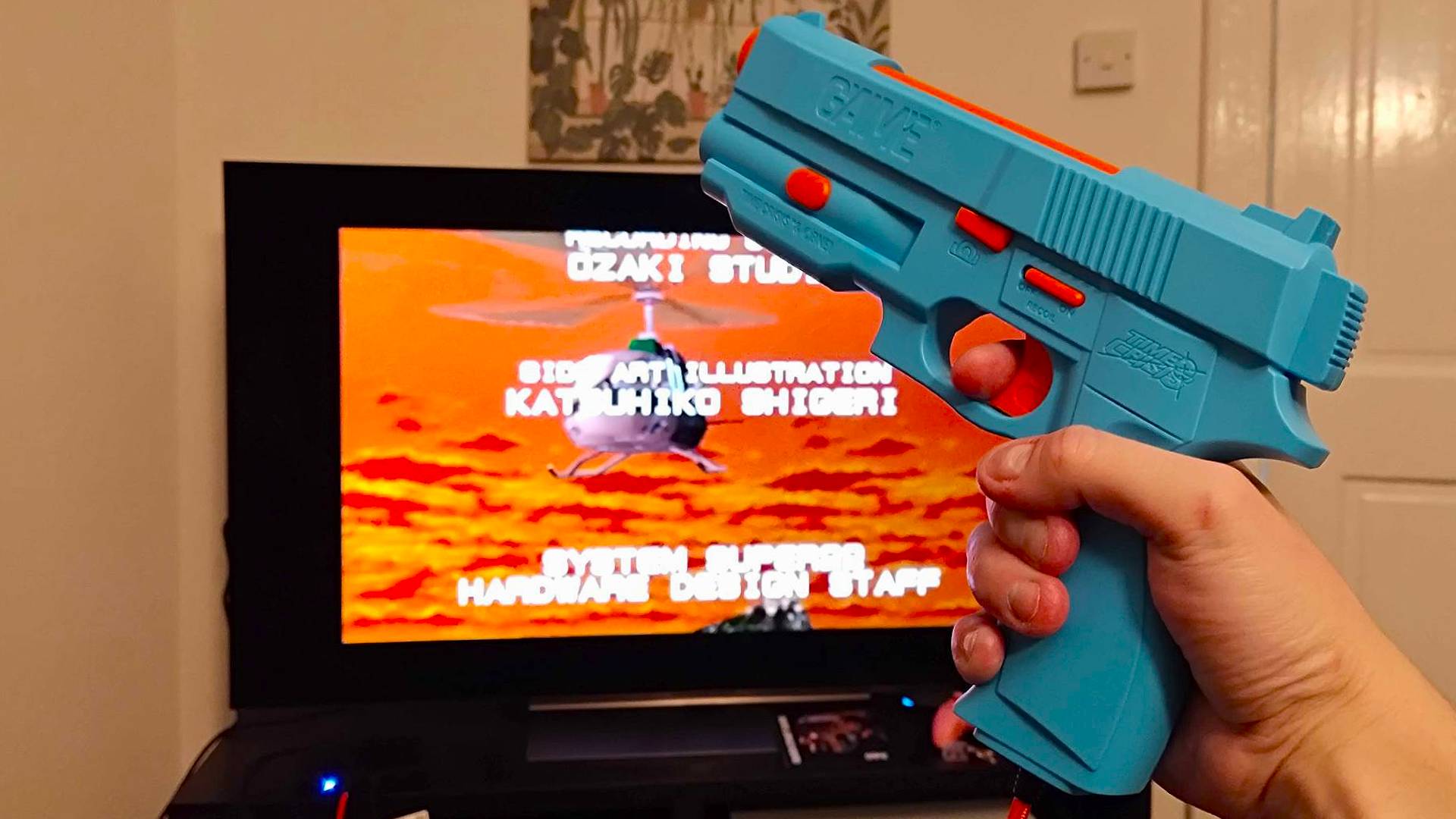
As a standalone package, the G’AIM’E Time Crisis console make for a fantastic tribute to an iconic shooter, and it could help revive the lightgun genre as a whole. I wouldn’t go as far to say that it’s cheap, but it does make for an affordable way to play Bandai Namco’s 1995 arcade adventure on a modern TV with authentic feeling plastic peripherals.
My main concern with the G’AIM’E console is the fact it’s standalone system with no new game prospects. I get that it’s singing from the same plug-and-play sheet as many other devices when it comes to being offline and having a set library, but it feels like this could have been an opportunity to give hard to play lightgun classics a proper platform home.
I am holding onto hope that Tassei Denki Co. is planning to sell new individual boxes in the future that will work with your existing guns and pedals for a reasonable price, but that could get complicated when it comes to playing something like Sega’s The House of the Dead with Bandai Namco designed pistols. I’d honestly even take a beefier box that comes with more settings and the ability to download different romps, but that should have perhaps been a thing in the first place.
I want to also stress that while I think the G’AIM’E Time Crisis console is great for casual players, lightgun enthusiasts will still want to opt for the Sinden Lightgun. It feels more like an original arcade peripheral thanks to its proper recoil mechanism, and it’ll work with virtually any shooter you can run on a PC. I wouldn’t remotely say the accessory is easy to set up, though, and that in itself is what should sell you on picking up the officially licenced plug-and-play bonx instead.
How I tested the G’AIM’E Time Crisis Lightgun console
For a week, I used the G’AIM’E Time Crisis console to play its built-in lightgun games on both a 55-inch LG OLED C4 TV and a secondary 43-inch Samsung LED display. To assess the system’s aiming accuracy, I played through the Bandai Namco shooter multiple times on the plug-and-play system as well as using a Sinden Lightgun with MAME on a PC to compare both experiences. I also used my experience with the original arcade machine and the PS1 GunCon version as a baseline to see if the new device could produce an authentic experience on modern displays.
In addition to comparing the G’AIM’E console’s version of Time Crisis in terms of gameplay using the Ultimate bundle's guns and pedals, I also played multiple sessions of Point Blank and Steel Gunner 1 + 2 in multiplayer mode to check whether using two peripherals impacted accuracy. Throughout all playthroughs, I also examined whether lighting conditions and other factors had an effect on gameplay.
For more information on how we test retro consoles and other gadgets, swing by our full GamesRadar+ Hardware Policy.
Looking for ways to play classics on the go? Swing by the best retro consoles for portable emulators and more.

Phil is currently the Hardware Editor at GamesRadar+ who specialises in retro gaming, the best gaming handhelds like the Steam Deck, and more modern components like graphics cards. Having spent years offering up classic console advice and over a decade as a gaming journalist for big names like TechRadar, The Daily Star, the BBC, Den of Geek, and many more, Phil now dedicates their days to covering the latest news and offering up invaluable setup advice.
You must confirm your public display name before commenting
Please logout and then login again, you will then be prompted to enter your display name.
